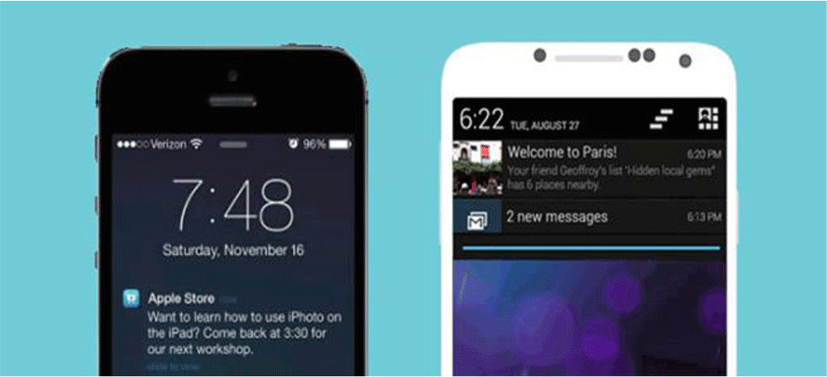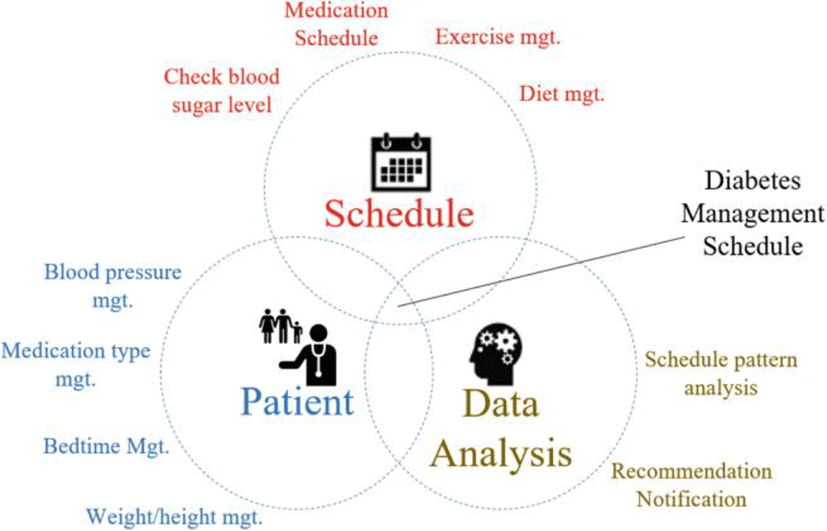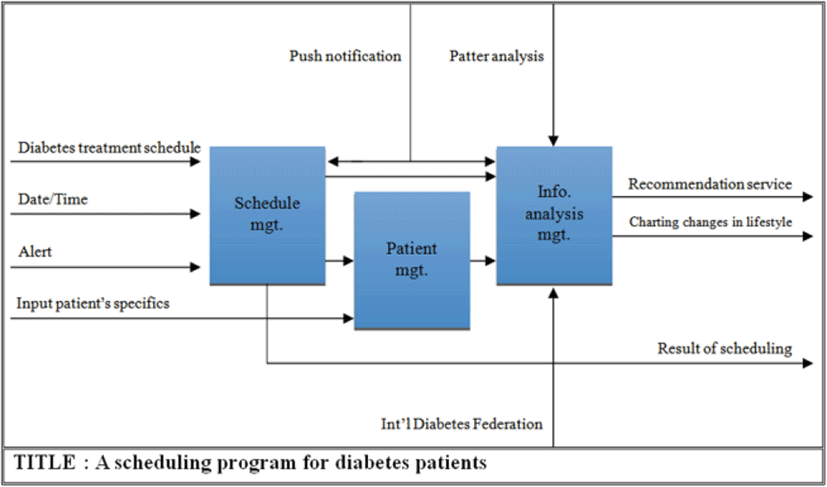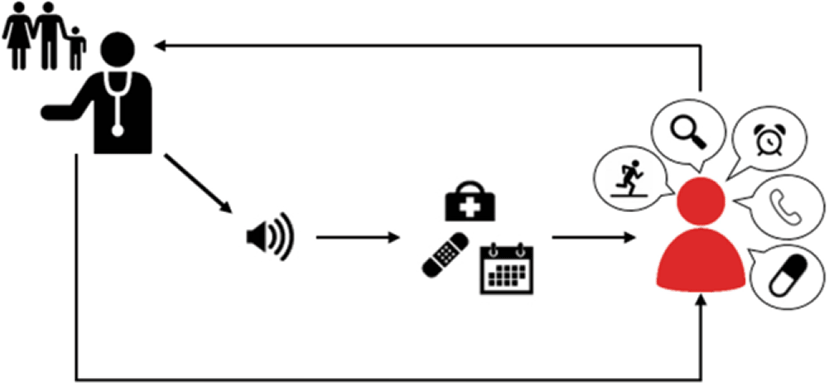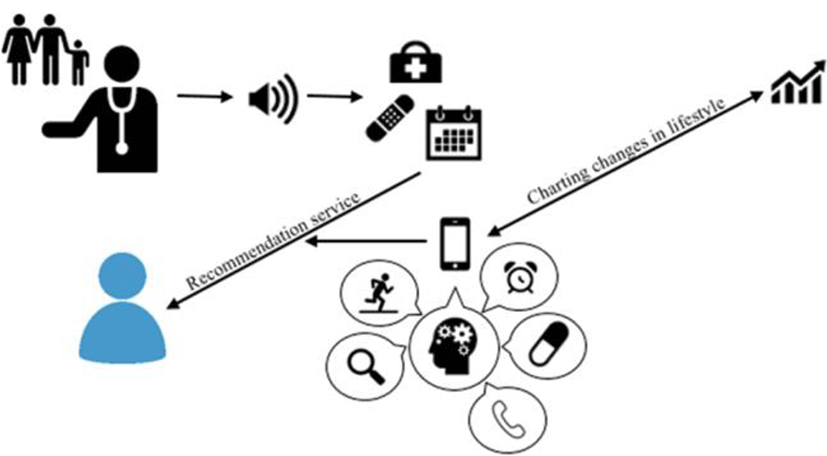I. INTRODUCTION
The importance of efficient time management has never been more important in our current busy world and the spread of the recent IT-applied schedulers is quite natural in every industrial sector as they offer much more specialized functions than conventional schedulers. Especially, in the medical sector, some of the specialized schedulers for the diabetic patients are increasingly playing a fundamental role. Nevertheless, there are some progress has to be made. Even though the conventional schedulers allow diabetic patients to schedule their own treatment or management schedule by themselves by offering convenient control functions, the factors such as nourishment, medication, weight, and exercise program should be considered when developing an adequate patient scheduler. However, it is not easy for these patients to understand the correlation between what they have scheduled and what effects would it bring without an expert medical knowledge. The scheduling program introduced in this study allows the patients to recognize the significance of controlled sugar level which can only be achieved through respective optimized treatment schedules. This program offers a convenient and flexible scheduling function along with the medical recommendations made through patient data analysis.
II. RELATED WORK
Diabetes is a chronic disease caused by an absolute or relative deficiency of insulin. According to the Korean Diabetes Association, the prevalence of diabetes in Korea increased from 12.4% in 2011 to 13.7% in 2014. It is ranked no.4 behind hypertension, hypertriglyceridemia, and hypercholesterolemia in prevalence in Korea (Korea Centers for Disease Control and Prevention, 2016). Furthermore, the prevalence of fasting blood glucose deficiency, a pre-diabetic prevalence that is very likely to progress to diabetes, is also very high at 24.8% (Korean Diabetes Association, 2016). Although the death rate related to diabetes is decreasing in developed countries, it is increasing in Korea (Kim & Choi, 2009), and diabetes has become one of the most serious chronic diseases in Korea.
The prognosis of the diabetes patient is determined by self-management such as the lifestyle like diet and exercise and the monitoring of blood glucose as well as medication (AADE, 2009). Mobile healthcare that uses mobile apps for self-management of diabetes patient has recently been widely distributed (Hunt et al., 2015). It is because the mobile devices can manage the lifestyle and communicate with the medical staff to effectively lower blood glucose without limitation of time and space (Liang et al., 2011).
Early studies of self-management by diabetes patients using mobile device mostly focused on a text message or SMS (short message service) for communication between the patient and medical staff such as providing information to the patients and guiding the medication time (WHO, 2016). According to a study of the systematic literature review of studies using text messages, such intervention through text messages has improved the health of diabetes patients and been effective in regulating blood glucose (Krishna & Boren, 2008; Krishna, Boren, & Balas, 2009). The mobile apps that run on Android, iOS, Windows and, BlackBerry mobile OS provide more than just text messages and provided intervention to diabetes patients. According to a meta-analysis of effects of 22 mobile apps, the mediation effect of the mobile app for diabetes self-management intervention was 0.5 for lowering glycated hemoglobin (Liang et al., 2011; Free et al., 2013). The mobile apps feature many functions including 1) to inform users the information related to diabetes and self-management in a variety of forms such as text, picture, and video; 2) to record data such as diabetes, diet, and exercise; 3) to display user data in charts and graphs; 4) to guide appropriate recommendation based on user input and basis; 5) to instruct the users in real time; 6) to remind users the medication time and hospital visit schedule; and 7) to facilitate real-time communication between patients and medical service providers (Aitken & Lyle, 2015). The literature review by Chomutare et al. (2011) showed that the most mobile apps for self-management of diabetes reflected the education, diet, weight management, exercise, communication with medical staff, insulin and oral medication management, foot management, and complications management that are recommended by standard clinical guidelines for diabetes management. However, the healthcare management apps were somewhat lacking in functions as the majority of apps only utilized the informing function, and almost no app provided the integrated functions (Aitken & Lyle, 2015). The self-management for diabetes was no exception, as few apps utilized the evidence-based guide, reminder/alert, social media, and interface to diabetograph (Chomutare et al., 2011). Only 20% of reviewed 137 diabetes self-management mobile apps provided the education customized for the patient condition (Chomutare et al., 2011). The customized education is necessary for diabetes since it is more effective to provide the information specific to each patient’s requirement and preference (Chae & Son, 2000). Moreover, the existing self-management for diabetes mobile apps utilized social media only indirectly by providing the simple links to well-known social network sites such as Facebook or Twitter or creating forum sites. No app directly utilized the social media functions such as sharing the user records or record results in graph or table forms with friends. However, Greene et al. and Hawn reported that education on medication management and encourage social support between patient groups through the social media such as Tweeter and Facebook increased the effectiveness of diabetes management intervention (Greene et al., 2011; Hawn, 2009). Fewer than 23% of existing diabetes self-management apps had the interface to the glucose meter for the exchange of data, and only one diabetes management app received wireless data from the glucose meters (Mulvaney, Ritterband & Bosslet, 2011). The diabetes patients, the elderly patients, in particular, need the automatic passive upload that minimizes manual user input. Therefore, recording the blood glucose level through the Bluetooth interface to the glucose meters can be a significant benefit (Aitken & Lyle, 2015).
3. A DESIGN OF DIABETES MELLITUS SCHEDULING PROGRAM FOR DIABETIC PATIENTS
The schedule management module manages the patient’s treatment plan through the periodic and systematic information provision (notification) function on a set time or date using a bell or a push service. Based on such information, the patient is able to check his/her average measurements as well as current health status. Figure. 1 describes the push (notification) service.
- Medication Schedule: Patient’s medical data is entered and stored on a daily or periodic basis.
- Blood Sugar Level Check: Patient’s blood sugar levels are entered and stored periodically together with pre or post-meal sugar levels, heart rates and the respective HBa1c test results.
- Exercise Management: The information relevant to the patient’s daily or periodical exercises is managed. The information includes exercise schedule, frequency and duration of each exercise.
-Diet management: Patient’s food menu and its salinity are stored along with his/her fasting status.
Manages diabetic patient’s specific information and the patient or the medical staff can check the records. The data such as height/weight, medication type and bedtime information are analyzed together with the blood sugar data obtained from schedule management to provide required analysis results or the averages of these data. Figure. 2 shows scheduling program for diabetic patients.
-
Management of patient’s blood pressure: After receiving the blood sugar information from the schedule management module, daily or periodical blood sugar levels are provided together with their averages. Warning/Safety indications are outputted after analyzing the data received.
-
Management of medication types: Stores and manages the medication types related to treatment such as insulin injection, insulin adjuvants (insulin secretagogue, etc.), antihypertensives (diuretic, etc.). The medication schedule for these types can be set according to the medication schedule registered in advance.
-
Management of average (regular) bedtime: Arbitrary regular bedtime is registered first and based on this information, patient can plan a suitable bedtime schedule for the patient to sleep soundly using the bell notification function on his/her bedtime and wake-up time. A warning message will be transmitted if the notification is not received properly.
-
Management weight/height: Weight and height data are periodically checked and quantified (BMI). Risk information will be provided depending on the result.
After collecting the data from schedule and information management modules, the behaviors suitable for improving patient’s lifestyle will be suggested through push notification depending on the situations. Figure. 3 shows BPM of scheduling program for Diabetic Patients.
-
Schedule pattern analysis: By combining patient’s specific data with the scheduled data related to prevention of patient’s sugar level increase, the analyses as to how the patient usually spends the day or if there are any constrains due to his/her specific symptoms. Also, the changes in his/her life pattern are charted periodically.
-
Recommendation notification system: Recommendations will be given after analyzing given schedule and patient information together based on time and date.
Figure. 4 shows design of scheduling program for diabetic patients (1), Also Figure. 5 shows design of scheduling program for diabetic patients (2).
4. CONCLUSION AND FUTURE WORKS
A self-controlled treatment scheduling program has been proposed in this study for the diabetic patients in a wide range of age groups who desire to improve their own health conditions. The program can be effective in improving their inadequate dietary or exercise conditions. This program adopts self-control approach and provides the necessary information essential for prevention or development of a new symptom which would lower their quality of life. This program is expected to contribute in reducing or at least slow down the rate of development of new diabetic patients. The program registration and disclosure as an open source program will follow in authors’ future work to contribute in developing a more effective and efficient diabetic patient management program.
This study is the first attempt of software engineering approach using a mobile push system for scheduling program and application for diabetes.
Therefore, the future studies will need to develop the diabetes self-management mobile app to provide the customized intervention based on IMB theory and ground that can systematically explain the change in diabetes self-management behaviors and evaluate it. The evaluation should check how the diabetes self-management mobile app changes the diabetes self-management behaviors and behavioral factors of patients.








